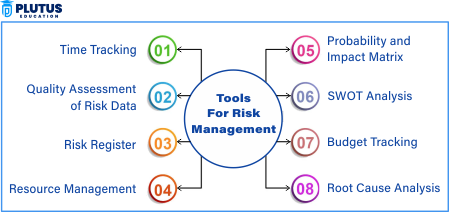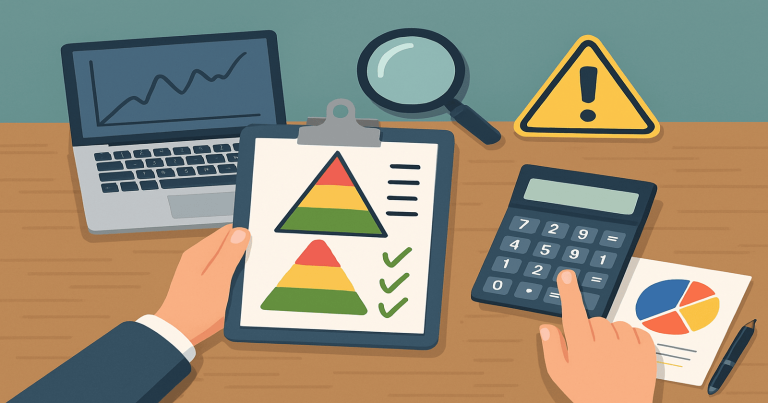PDF: https://plutuseducation.com/pdf-viewer?u=https://plutuseducation.com/blog/wp-content/uploads/2025/03/Risk-Management-Tools-.pdf
Risk Management Tools for Small Businesses and Firms
No matter how big or small, every business is accompanied by some kind of risk; money, laws, customers or the market are all risks that can seriously threaten your sanity and the bottom line. To meet them, people use what are known as risk management tools such items help you to locate hazards ahead of time and nip them in the bud before anything bad happens. Therefore, the answer to “What is risk management tools?” is simple, maybe. Company methods or systems that serve as your focus for finding, examining and putting right problems before they adversely impact your business.
They are indispensable in any kind of business. The larger companies have whole teams handling risk matters. But small businesses also need to be prepared. One small problem can have very serious consequences. A thoughtful business owner will actively use risk management tools to avoid losses and make better plans. By having proper tools, a business gets itself ready for coming trouble. It can immediately take steps to stanch the loss. It will also help the business grow in a careful way. By good planning and taking early measures, we save not only time but also money. These tools for making better decisions with fewer errors can also be helpful in all kinds of ways.
What are Risk Management Tools?
They help you to find out where the hazards lurk and how bad any individual one can get. Prompted by these tools, companies may decide what precautions they need in terms of safety or environmental protection. Such measures make some sense — if nothing else, they slow down moment by moment decision-making at critical junctures.
There is no enterprise without risk. If you don’t think about risks, then you’ll encounter major headaches (not just little worries later). With a list, you can avoid all of that. Using these tools enables you to study it properly. Instead of guessing, you can gather all kinds of facts and figures. Then you’ll be well-equipped to make your decisions on Frankly.
Now, these tools can be employed to fulfill many different functions. Some ensure that the company meets legal requirements. Some check if a plan has any hope of success or failure. Still others allow you to communicate openly with your team to exchange ideas back and forth. Good tools should allow you to contemplate a problem from every possible angle.
If you want to open a new store, the tools can tell you if the market is right; if there are competitors nearby who might become your target; and so forth. Or if you plan to borrow money, they will allow you to see whether you are in good shape cash wise. They are examples of how real and useful the tools are.
The most frequently employed risk management tools include Risk Registry, SWOT Analysis, Rothko’s risk matrix, Monte Carlo Simulation, Scenario Analysis, Engineering reviews and compliance software. Each tool has its own job. Some are as simple as paper. Others are systems or software. You have to find the one that fits your work best.

Importance of Risk Management Tools
Choosing the right tools of risk management is essential for an enterprise to be both clean and efficient.The big harm is nipped in the bud for you.Many small businesses in India close down because they never gave the slightest thought to risks.These tools help you to make the smart quick decision.The nearer you are to the site of danger, the earlier you can take action.
Don’t wait until the problem grows rather than solve it in embryonic form.This will save time and money.The tools also make for more self-assurance.It doesn’t mean haphazard guesswork, but as soon as the facts are clear you act right away.An increasing number of equals in society believe that businesses with accurate risk tools must be trustworthy.
Such tools indicate that you are both safe and serious in business Banks, investment houses and partners all tend to trust you well.
- Better Decision Making: With the tools one can see precisely where danger lies and take the appropriate step.
- Loss be stopped: In its early days, lawsuits are stopped from coming fully into force.
- Group brainstorming: Tools help whole teams to think together.
- North Law and Rules: Many tools help follow laws or oblige regulations. Risk tools even help you to establish a culture of caring and planning.
Each member of the team is attentive and thinks before he acts. This sort of thinking is especially important in a very changeable world like today’s.From new laws to net frauds, it all changes fast. So no matter whether you own a small kirana store or a growing high-tech company, risk management tools are your clever little helpers.
Types of Risk Management Tools
Businesses use various risk management tools to prevent any unwanted liabilities. Each organization here has one way to solve a problem with which it is dealing. While some supervisory tools allow you to know the potential risks, others provide you with the opportunity to learn about the risk or keep the corresponding record. Some tools integrate transparent and easy access to get through the risks of planning for the unforeseen. The companies have to select the tools that are suitable to them with the expertise, manpower, and budgets that they have.
Tools That Help Identify Risks
Some of these tools are aimed at figuring out where potential lines of attack may lie. SWOT analysis is one such tool, which serves this purpose. In SWOT, you look at strengths, weaknesses, opportunities, and threats. This helps you understand the business from all fronts. Once threats appear, it’s time to start figuring out which risks they foreshadow.
Brainstorming is another way to identify risks. This means you gather with your team and discuss what can go wrong. Then you write all the ideas that come up and systematically examine each one in light of others ideas. Businesses also use interviews or discussions with experts to collect hidden risks that are hard to see from the outside.
Tools That Help Study and Analyse Risks
After the risks we will concerned with the next step in the Risk Matrix.Of all the available tools,the risk matrix is the most commonly used for this part.In a risk matrix you first estimate how probable a risk is; then you estimate the amount of damage it will do.Next you rank the risks.Risks with high probability and impact should be given top priority and fixed first. Risks with low probability and impact should be left until later or watched closely till they develop. Monte Carlo simulation is an electronic tool that is based on the mathematics of chance and statistics. It can show what will happen in advance by using numbers to represent different business environments. It is often very difficult to be sure about many things, as in sales and stock-market trends; this technique is invaluable for that kind of work
Another research tool in english translation is the Failure Mode and Effects Analysis (FMEA).It is used to find the points at which any procedure might go wrong-and tells you how severe will be the results, how often it should ocur.This technique is widely used for making products and managing service flows.
Tools That Help Track and Monitor Risks
It’s always important to be aware of other risks too, often times businesses just wanted standard procedures revised but people whose work affected the projects were always faced with opposition from their bosses, public or even counterproductive implementations that let it my job yet always In terms of expression, Liu has been as effective in FIFA games as football has been in China’s.Besides, you can not ignore all the other risks. A risk register is just one rentable tool for doing this.The risk register is like a big table where you list all the risks, their details, and what action you will take. You Also keep updating risk as time goes on. This will help you stay alert and ready.
Another tool is Key Risk Indicators (KRIs). These are signs that something may go wrong soon. If one of the signs shows a problem, you act before the full risk comes. This is helpful In general business and finance But it is also informations tracking
Risk dashboards are software tools that show all your risk details in one place. You can see charts, tables, warnings and even a timeline. Big firms use them; now small businesses also use less expensive editions
Tools That Help Plan and Act on Risks
Once one has discovered and analyzed risks, it is necessary to act accordingly. Scenario analysis is a tool of reflection; in this way, you think about the future. You ask each other, “If this, Call us some different things first.” And you also think: What kind will you undertake in the best case, normal case and worst case? This is very useful in times when it looks like a direction may be needed for marketing or law.
Compliance management tool, the range of Taxsoft is also a painkiller for compliance management. These can be the law amendment information, tax systems and software of this kind replacing paper tax returns You just take 1 change in differentiation, and then maybe you will find that is more necessary for safety tax returns.
This is the ideal time for using internal audit tools as well. They check to see whether or not the measures you take are working. They will help you correct things before an external authority finds them out and tell them their findings as they do so.
All of these kinds of tools are extremely useful for ensuring that your business is out of harm’s way. Some are available for free; others are software programs that will cost you money. By using Excel or an online app, you can even convert basic forms of many tools into prototypes that are cpmpatible with existing business practices. The main thing is to employ the right tool at the right time.
Risk Management Tools
Now let us consider several popular and widely used risk management tools one by one. Such tools are convenient for students, start-ups and small firms. But the general public’s understanding of cybersecurity is limited. Most employees aren’t properly informed about security awareness.
Risk Register
This is a simple yet strong tool. It is an array of cells, organized one for each possible risk that might be on the horizon or other things to consider afterwards. With impact, chances and what action you are going to take next—in a three-row table tabulation. You also note the person to be responsible for this hazard. This way these risks can be tracked, and at a glance we know whether anything has changed over time.
SWOT Analysis
This has been a definite help in moving towards bigger plans and also in bringing a new project to the daylight. It presents what kind of challenges you’re expecting, both internally and externally, and gives you options to prepare beforehand. Apart from this, you also have the opportunity to come to know your weak linkages and the precise areas you should concentrate on for the sake of future improvements.
Risk Matrix
This is a great tool that can assist in prioritizing risks. A risk map graphically represents the probability and impact of any investment/project failure in the matrix. This makes your risk plan focused and strong.
Scenario Analysis
Through this function, you are equipped for any form of development that might happen in your company. It is very successful to use it for the occasion, when you are introducing a new location, or even when you realize that your target market has changed. It is a tool that will let you go forward and act with confidence whether you will meet a good or a bad change.
Compliance Tools
They are instrumental in abiding by all the rules, tax laws, and licenses. They send alerts and reminders. You never miss a date or a form. Small companies may turn to simple applications or online GST and labor law tools for this purpose.
Relevance to ACCA Syllabus
The ACCA syllabus requires that candidates appear for its exams in SBL (Strategic Business Leader) and AFM (Advanced Financial Management). Students will have to list risk assessment procedures, then rate them according to severity and suggest relevant risk control means to defend against this menacing background uncertainty for business. One apparent result of knowing these measures is better strategic planning and perhaps new principles of internal control systems-thus vital to passing case study type exam questions.
Risk Management Tools ACCA Questions
Q1: Which of the following tools is commonly used in ACCA for identifying and evaluating enterprise risks?
A) Trial Balance
B) SWOT Analysis
C) Depreciation Schedule
D) Accruals Concept
Ans: B) SWOT Analysis
Q2: What does a Risk Register typically include?
A) Only internal risks
B) List of company assets
C) Identified risks, their likelihood, impact, and mitigation plans
D) Only financial ratios
Ans: C) Identified risks, their likelihood, impact, and mitigation plans
Q3: In risk assessment, what does the risk matrix evaluate?
A) Tax rates across jurisdictions
B) Probability and impact of risks
C) Discounted cash flows
D) Current ratio
Ans: B) Probability and impact of risks
Q4: Which risk management tool helps ACCA students understand potential future outcomes under uncertainty?
A) Audit Trail
B) Monte Carlo Simulation
C) Variance Analysis
D) Reconciliation Statement
Ans: B) Monte Carlo Simulation
Q5: What is the main purpose of scenario analysis in risk management?
A) To prepare tax filings
B) To identify accounting fraud
C) To evaluate outcomes under different assumptions
D) To conduct ratio analysis
Ans: C) To evaluate outcomes under different assumptions
Relevance to US CMA Syllabus
Management of risk has been incorporated into Part 2–Strategic Financial Management of the US CMA syllabus. In order to achieve the aim, candidates can learn to see financial risks and business operational The first step is using risk maps or scenario planning for even greater clarity. How much risk can you handle? Use derivative to control risks!
Risk Management Tools CMA Questions
Q1: Which risk tool helps in evaluating multiple possible outcomes in capital budgeting?
A) Risk Register
B) Variance Analysis
C) Scenario Analysis
D) Balanced Scorecard
Ans: C) Scenario Analysis
Q2: In US CMA, which tool is best for quantifying risk using probability distributions?
A) Monte Carlo Simulation
B) Financial Statements
C) Dupont Analysis
D) Budget Forecasting
Ans: A) Monte Carlo Simulation
Q3: Which of the following is an example of an operational risk management tool?
A) Net Present Value
B) Cash Flow Forecast
C) Internal Controls Checklist
D) Current Ratio
Ans: C) Internal Controls Checklist
Q4: What is the key feature of a heat map in risk analysis?
A) Tracks past financial performance
B) Shows levels of risk based on color codes
C) Measures liquidity
D) Calculates depreciation
Ans: B) Shows levels of risk based on color codes
Q5: In risk management, the purpose of Key Risk Indicators (KRIs) is to:
A) Monitor changes in tax policies
B) Signal potential risk events before they happen
C) Measure employee performance
D) Track shareholder returns
Ans: B) Signal potential risk events before they happen
Relevance to US CPA Syllabus
Candidates have to appreciate in the United States CPA exam Business Environment & Concepts (BEC) and Auditing and Attestation (AUD) sections you understand such as corporation enterprise risk managemen, evaluation of control risk and operating environment for internal control structure. To design and assess audit procedures, to present the client risk mitigation options – knowing how use or interpret risk management tools is necessary.
Risk Management Tools CPA Questions
Q1: What does the COSO framework primarily focus on?
A) Tax Accounting
B) Risk and internal control assessment
C) Depreciation methods
D) IFRS application
Ans: B) Risk and internal control assessment
Q2: Which tool helps CPAs document risk in audit planning?
A) Audit Risk Model
B) FIFO Calculation
C) Journal Entry Logs
D) Income Summary
Ans: A) Audit Risk Model
Q3: What is the purpose of a control self-assessment in risk management?
A) To manage marketing costs
B) To verify if internal controls are working
C) To prepare financial statements
D) To value inventory
Ans: B) To verify if internal controls are working
Q4: Which of the following tools best supports enterprise risk governance in CPA practice?
A) Monte Carlo Simulation
B) Risk Committee Reports
C) Bank Reconciliation Statement
D) Vertical Analysis
Ans: B) Risk Committee Reports
Q5: A CPA uses a Risk Matrix in a client audit to:
A) Identify fraud
B) Evaluate likelihood and severity of risks
C) Record fixed assets
D) Calculate gross margin
Ans: B) Evaluate likelihood and severity of risks
Relevance to CFA Syllabus
As far as certainty is concerned, in the Portfolio Management and Quantitative Methods part of the CFA Level I and II curriculum, this topic gets thorough treatment. What should you ask the candidate to do? Identify the risks he would face during his tour. Provide measures, such as Value-at-Risk (VaR), which a firm can use before taking unnecessary and unproductive risks with its assets. Use scenarios or “stress testing” to think through what would happen under different conditions of uncertainty, than you actual hear about results Management; what effect it has on expected returns and You what combination of risks makes up any such expected rate of return To that end, these tools help portfolio optimization and investment risk control tremendously.
Risk Management Tools CFA Questions
Q1: In the CFA syllabus, what does Value-at-Risk (VaR) measure?
A) Asset returns
B) Potential loss in value over time at a given confidence level
C) Future stock price
D) Interest rate spread
Ans: B) Potential loss in value over time at a given confidence level
Q2: Which tool is best suited to understand tail risk in investment portfolios?
A) Moving Average
B) Monte Carlo Simulation
C) Return on Equity
D) Compound Interest
Ans: B) Monte Carlo Simulation
Q3: What does stress testing in risk management show?
A) The average expected return
B) Market capitalization
C) Portfolio performance under extreme conditions
D) Historical trading volume
Ans: C) Portfolio performance under extreme conditions
Q4: A portfolio manager uses scenario analysis to:
A) Track past returns
B) Predict stock prices
C) Understand outcomes under different economic situations
D) Adjust dividend policy
Ans: C) Understand outcomes under different economic situations
Q5: Why do CFA candidates study risk-adjusted return tools like Sharpe Ratio?
A) To compute tax liability
B) To measure efficiency per unit of risk
C) To match expenses with income
D) To compare revenue
Ans: B) To measure efficiency per unit of risk


